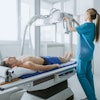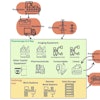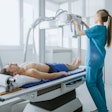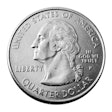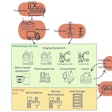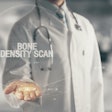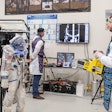Coronary CT angiography (CTA) can help pinpoint asymptomatic patients at high risk for adverse events after coronary artery bypass graft (CABG) surgery, researchers reported at the 2008 RSNA annual meeting.
A study of 118 asymptomatic patients showed that those with signs of graft failure on electrocardiogram (ECG)-gated coronary CTA in the three months following bypass surgery had a significantly higher chance of needing repeat catheterization or suffering a major adverse cardiac event in the next year, compared with patients with unremarkable grafts, said Dr. Pal Suranyi, Ph.D., from the department of radiology at the Medical University of South Carolina in Charleston.
The patients, who received a total of 251 grafts, underwent contrast-enhanced ECG-gated CTA of the entire chest three months after CABG surgery. Images were acquired using either 16-slice or 64-slice CT scanners.
Thirty-two patients showed signs of graft failure -- occlusion, stenosis, plaque formation, or surgical complications -- at three months. Eight patients were excluded from further analysis due to immediate intervention by the cardiac surgeon based on the CT findings. Eighty-six patients showed unremarkable grafts.
During more than 12 months of follow-up, 5% of patients with unremarkable grafts on coronary CTA underwent repeat catheterizations, versus 22% of patients with signs of graft failure. Nineteen percent of patients with unremarkable grafts had a major adverse cardiac event, defined as recurrent angina, myocardial infarction, repeat revascularization, or cardiac death, compared with 50% of patients with signs of graft failure.
Surgeons found CTA useful for a variety of reasons, Suranyi said. "It provided an opportunity to observe previously placed grafts for position, enabled [physicians] to view anatomic properties such as vessels close to the sternum that could be injured during surgery, and of course provided extracardiac findings."
"Even in the absence of symptoms, individuals with early signs of graft failure on routine follow-up coronary CT angiography after CABG surgery may benefit from closer monitoring and more aggressive treatment," he told attendees.
By Charlene Laino
AuntMinnie.com contributing writer
December 11, 2008
Related Reading
Coronary CTA identifies ACS patients ready for ED discharge, December 9, 2008
Scientists doubt utility of CT scan as heart test, November 30, 2008
CT not ready to replace conventional coronary angiography, November 26, 2008
Coronary CT effective for triage of patients with acute chest pain, November 11, 2008
CT angiography aids risk stratification in patients with chest pain, November 3, 2008
Copyright © 2008 AuntMinnie.com
